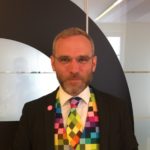For my third and final blogpost for LGBT+ History Month, I would like to reflect on queer spaces, that is, venues for LGBT+ people. For Pride Month in 2020, IP Out held a virtual tour of Soho, guided by the incomparable Dan de la Motte, looking at the history of some of those spaces, mainly from before decriminalisation when activities were necessarily covert. In the distant time before Covid-19, I went to an exhibition at the Whitechapel Gallery on Queer Spaces (https://www.whitechapelgallery.org/exhibitions/queer-spaces-london-1980s-today/). What is very evident is how many important venues are no longer with us.
In the 1970s and 1980s, Earl’s Court was an important queer destination – there was a gay hotel, the Philbeach in Philbeach Gardens; one of the most important gay bars, the Colherne; and a club called Bromptons, and doubtless other venues of which I am unaware. All have now gone. It seems to me quite extraordinary that the queerness of a district can be almost entirely erased.
The gay centre of London moved to Soho, and then south of the river to Vauxhall – the site of one of the few real survivors amongst gay venues, the Royal Vauxhall Tavern. I used to attend the Sunday evening performances there of the Dame Edna Experience with almost religious devotion.
While many of the iconic venues for drag performance have closed down, such as the Black Cap in Camden and the Black Horse on Mile End Road, new venues have opened in other places, such as The Glory in Haggerston. The scene is in constant flux.
It seems that the pressure of ever increasing commercial rents means that, with some notable exceptions such as the Royal Vauxhall Tavern, the Admiral Duncan (which not even a bomb attack could close down) and Comptons, the expected lifetime of a commercial venue is rather short.
The commercial scene is not without its drawbacks. It’s not optimal that young LGBT+ people are given the impression that meeting and socialising should be primarily focussed around drinking. And ultimately venues are there to make money for the owners and the landlords, not to serve the community. There was therefore a drive to create venues that were not primarily commercial in character. There was the London Lesbian and Gay Centre and even in sleepy Oxford there was the Oxford Lesbian and Gay Community Centre, housed in Northgate Hall. Section 28 is credited with the demise of most of these venues – many received some local authority support and when this was prohibited, they became unviable. But I am struck by the fact that the legislation was repealed in 2003, but there has been no real reversal of the closures. Of course digital connectivity means that people are no longer as reliant on physical spaces as we once were, but the absence of effective LGBT+ spaces other than the commercial scene strikes me as sad.
Bucking the trend of the short lifetime of queer spaces is the splendid Gay’s the Word bookshop. It’s been going since 1979 and is still going strong, defying digital media and online ordering. It was famously raided in 1984 and charged with selling obscene materials, but the charges were finally dropped in 1986 (https://www.theguardian.com/world/2019/jun/28/gays-the-word-bookshop-sold-obscene-material-archive-1985).
Many cities across the world have their queer centres. When I first came out I heard tales of Manhattan and the Castro in San Francisco, where there were not just gay venues, but gay restaurants and gay versions of pretty much every type of locale. I could hardly believe it. What, you mean like a restaurant, but gay?
When after university I went to do a postdoc in Tokyo, I naturally sought out its most famous gay district, Shinjuku-ni-chome. It has a huge number of tiny venues in a very small district of just a few blocks, many of which did not welcome non-Japanese people, or in some cases anyone who was not introduced by an existing client. It wasn’t until a lot later that I learned the reason why this location had become a gay hotspot. It had been a red light district, but in the run-up to the 1964 Tokyo Olympics, city officials were concerned about the reputational damage of prostitution being carried out so close to Shinjuku Station, Tokyo’s largest transport hub, and so the prostitutes were ordered to move out. This left a supply of vacant and therefore inexpensive venues for enterprising gay business owners to take over. Because of its associations, people tended to avoid the area, and so discretion was easily achieved. It seems that it is of such serendipities that queer locations come about.
Physical places are important in history – civic buildings, cathedrals, monuments clearly stand as markers to the history of a place and a people. Queer history likewise wants its spaces, but the LGBT+ community has struggled to claim particular spaces with any lasting continuity. So much that I remember, or that existed but I never had the chance to visit, is no longer there.

Darren Smyth, IP Out committee member
Page published on 22nd February 2021
Page last modified on 22nd February 2021
